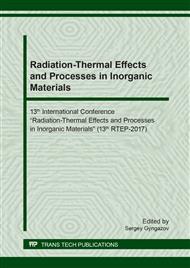p.53
p.58
p.64
p.70
p.76
p.82
p.88
p.95
p.101
Electron-Ion-Plasma Doping of Aluminum Surface with Copper and Titanium - A Comparative Analysis of the Formed Structure and Properties
Abstract:
Deposition of a titanium or a copper film onto the surface of commercially pure A7 aluminum and irradiation of the “film/substrate” system with an intense pulsed electron beam are carried out in a single vacuum cycle. Formation of a surface doped layer with a thickness of (20-30) μm is revealed. It is shown that the modified layer has a multiphase structure of a cellular rapid solidification of the submicron-nanosized range. Irradiation parameters are determined. It is established that the developed modification method allows forming a surface doped layer with the microhardness more than 4 times (Ti-Al alloy) or more than 3 times (Cu-Al alloy) greater than the microhardness of A7 aluminum; the wear resistance of the surface alloy Ti-Al exceeds the wear resistance of the initial aluminum in ≈2.4 times; doping of aluminum with copper is accompanied with an increase in the wear resistance of the material in ≈1.5 times.
Info:
Periodical:
Pages:
76-81
Citation:
Online since:
September 2018
Price:
Сopyright:
© 2018 Trans Tech Publications Ltd. All Rights Reserved
Share:
Citation:


